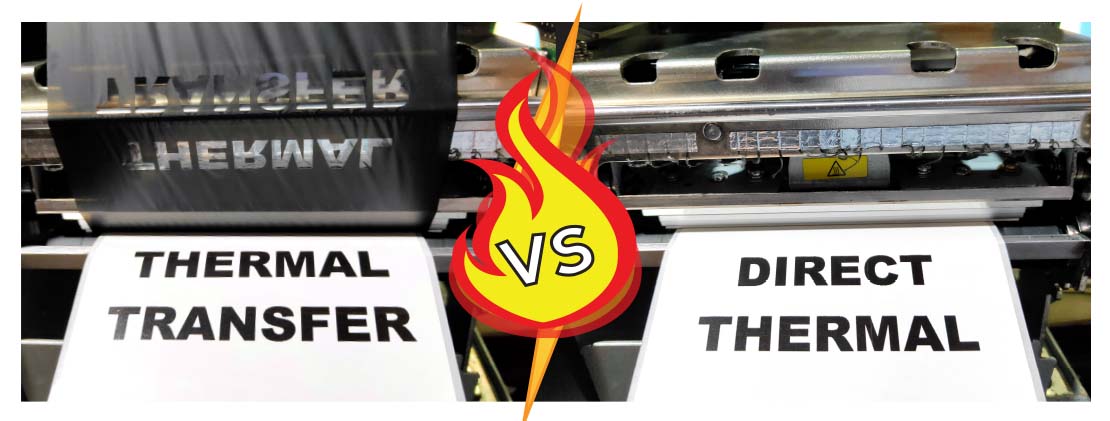
THERMAL TRANSFER VS DIRECT THERMAL: MECHANISMS, PROS & CONS
Article by Nicholas. Updated July 01, 2020
In label manufacturing & printing industry, printing data on labels & tags can be done by two options; thermal transfer and direct thermal.
Let's start things off by understanding the terms "thermal transfer" and "direct thermal". What do they mean and how do they work?
THERMAL TRANSFER PRINTING
Product example : security labels, warranty labels, removable labels, cold room labels, computer labels, pharmaceutical labels, satin labels, etc.

Thermal transfer printing uses a thermal print-head to transfer heat to a thermal transfer ribbon. A thermal transfer ribbon is a thin film with a special black coating on one side. This coating is made from wax or resin formulation. The ribbon is ran between the label and the printhead, with the coating side facing the label. As the ribbon and label pass over the printhead, the heat from the printhead heats up the ribbon's coating and is transferred from the ribbon to the surface of the label to form the image.
| PROS | |
|---|---|
| Label longevity | This technology creates incredibly strong printed images that can resist extreme temperatures as environmental factors do not alter the print quality as compared to direct thermal labels. Besides that, it can withstand ultraviolet exposure, sterilization and most chemicals. Thermal transfer printers are recommended if consumers demand for labels to last longer than six months. |
| Excellent print quality | Thermal transfer printing provides high image quality that is unmatched by other on-demand printing technologies. With suitable pairing of label and ribbon, thermal transfer printing is able to produce crisp, sharp, dark black print quality with high scannability barcodes. Thermal transfer printing also prints colour via colour ribbons, providing visual cues to product identification. |
| Wide media variety | Aside from the usual direct thermal counterparts, other materials such as paper, polyester and polypropylene are compatible for both standard and weatherproof prints as well. Each material has its own unique features that can be distinguished by its glossiness, ease to tear, waterproof attribute, etc. Furthermore, these materials are easily sourced. |
| Counterpart longevity | Continuous printing could lead to abrasion to the printer's printhead. Fortunately for thermal transfer printing, a ribbon's back coat protects the printhead from the ongoing tearing. Hence, a thermal transfer printhead can outlast a direct thermal printhead by two to four times. |
| CONS | |
|---|---|
| Costly | Its limitation is associated with the ribbons. In order to continuously print with high quality, ribbons have to be replaced frequently which make the process more costly upfront. |
| Time consuming | The whole thermal transfer printing process is time consuming. As compared to direct thermal printing, more time is used to load the media. Besides that, there is a need to always change ribbon periodically which takes up time as it accumulates in total. |
| Not environmental-friendly | Thermal transfer ribbon is not biodegradable. Disposing the used ribbons becomes harmful to the nature if it is not managed proficiently. |
DIRECT THERMAL PRINTING
Product example : shipping labels, receipt labels, name tags, visitor passes, etc.

Direct thermal printing has a simpler mechanism that uses a print-head to transfer heat to a thermal label instead of a thermal transfer ribbon. Thermal label has a unique coating on the its surface that allows them to be printed using the direct thermal printing method. With this functionality, it removes the need for ink, toner, or printing ribbons. The label contacts directly with the printhead which heats up its special coating. The darken desired image is then formed on the label in the printhead's path. However, the final product's durability is short.
| PROS | |
|---|---|
| Easy & eco-friendly | Direct thermal printing creates images by using only heat. Hence, ink, toner, or ribbons are not required. No ribbon usage reduces the amount of by-products and non-recyclable waste too. |
| High time conservation | Without the need of ribbon, time is saved when reloading the printer. In fact, it saves great amount of labor time which involves adjusting the printer's settings & reloading it periodically. |
| Low maintenance cost | Fewer moving pieces & parts leads to fewer chances for problems to occur. Direct thermal printing is easy to maintain and operate. |
| Simple | When you opt for thermal labels, label manufacturers do not have to worry about ordering the wrong ribbon & label sizes or care about the ribbons wrinkling when printing. Direct thermal printers are more compact which uses less physical inventory to store it as they forgo the use of ribbons. |
| CONS | |
|---|---|
| Short durability | Printed area will fade over time as the material is heat-sensitive. Excessive light or additional heat could darken the entire paper. This could render the text unreadable and barcodes unscannable. Hence, it is not recommended for direct thermal printing to be used for lifetime identification applications. |
| Limited color choices | Direct thermal printers only print in black & white. It does not allow for colored graphics or logos. Barcodes are printable with only black & white information. |
| Slow print speed | A sharp image is crucial when it comes to printing, especially for bar code. Direct thermal printer works well only at slow print speed. It is slow at nature because increasing its speed would cause heavy damages to its printhead. This leads to great concerns as manufacturers bear additional costs to replace the printhead more often. |